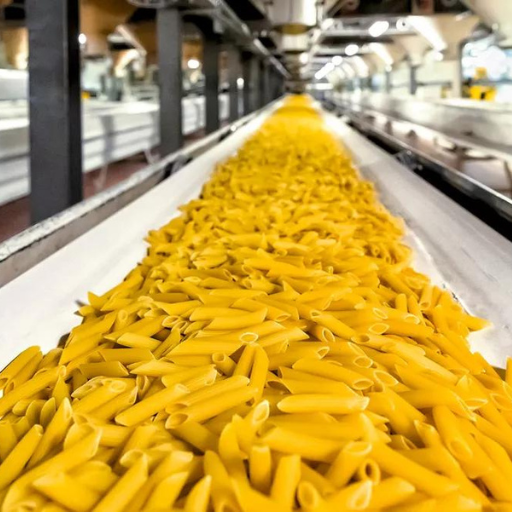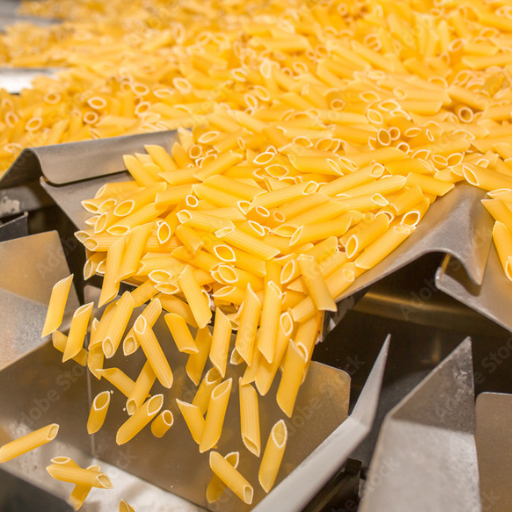In today’s competitive culinary landscape, the demand for fresh, high-quality pasta continues to rise. Whether you are a small-scale artisan pasta maker or a large-scale commercial producer, having the right pasta manufacturing equipment is essential for ensuring efficiency, consistency, and superior product quality. This comprehensive guide is designed to provide you with an in-depth understanding of the various types of pasta manufacturing equipment available, their functionalities, and how they can enhance your pasta production process. By the end of this article, you will be well-equipped with the knowledge to make informed decisions about the equipment that best suits your production needs and goals.
Understanding the Pasta Production Process
Essential Steps in Manufacturing Pasta
Pasta manufacturing consists of a number of steps that are critical for ensuring high-quality pasta production. Every business trying to optimize its pasta-making process must know and understand these stages.
- Mixing and Kneading: The initial step involves mixing durum wheat semolina or flour with water to form a dough. This mixture is kneaded until it attains the right texture. The levels of hydration noted here usually range from 30 – 32% (water by weight) while the duration of kneading generally lies between 8-12 minutes.
- Extrusion: An extruder then receives the dough and molds it into various pasta shapes using different dies. Normally, the temperature during extrusion should be kept at around 40-50°C, so as not to compromise the quality of the dough. Moreover, the pressure required when extruding also varies depending on types of pasta and may range from sixty bars up to one twenty bars.
- Drying: Following extrusion, pasta has to be dried down to about 12-13% moisture content for shelf-stable conditions. In this case, controlled drying proceeds through several stages where temperatures are within 40°C -60°C. Depending on drying conditions and type of pasta, complete drying can take hours or even days.
- Cutting/ Shaping: Cutting may be done after some forms have been made through extrusion .That is necessary for consistency in shape and size in end products hence uniformity.
- Pre-Cooking (Optional): Pre-cooking is important especially when producing pastas meant for ready-to-eat dishes. With respect to this step, pre-cooking times vary between 1 – 5 minutes while temperatures are near boiling point i.e., approximately ninety five degrees Celsius up to one hundred degrees Celsius.
- Cooling: Once dried or pre-cooked, air cooling brings down the temperature of packaged products so that there will not be any condensation inside the packaging.
- Packaging: The last stage is concerned with casing the pasta in waterproof bags or cartons. Such packing machines should work in a clean, controlled atmosphere to avoid contamination.
Understanding and controlling these essential steps enable pasta makers to realize consistent and quality production that meets market needs. Every step requires appropriate equipment for it to be successful, efficient and maintain the integrity of the pasta.
Key Pasta Machinery and their Functions in the Process
- Mixers/Kneaders: These are essential machines at the initial stages of pasta making. Mixers form a consistent dough by combining semolina flour and water while kneaders develop gluten in the dough hence its elasticity and firmness which determine quality pasta.
- Extruders: Shaping of pasta primarily depends on extrusion machines. They push dough through specially designed bronze or teflon dies in order to create different forms of spaghetti, penne etc. Die selection also affects surface texture of pasta.
- Cutters: Once out from extruders, cutters shape the final length of pastas as they are required. For example long shapes such as fettuccine or lasagna sheets require uniformity in length that would match cooking time hence packagi
- Drying Systems: Controlled drying ensures that moisture is removed without compromising on quality. Modern drying systems use temperature control, humiditycontrol, air circulation control among others to dry down pasta evenly so as not only preserve its texture but also prevent crackin
- Pre-Cooking Equipment: Pre-cooking units are used for ready-to-eat pastas. Partial cooking reduces preparation time before consumption since it still has to be fully cooked during meal preparation times.Machines involved maintain accurate control over duration/timerange of cooking as well as temperature within this range for even distribution/penetration
- Cooling Machines: After being dried or precooked, the pasta is then cooled using cooling systems that will rapidly bring it to room temperature. This is to prevent formation of condensation on the packaging which might lead to molds.
- Automatic Packaging Machines: The moisture proof material bags or boxes contain this pasta as they are packed by these very efficient and automatic machines. Some of the features found in modern packing machine includes vacuum sealing and modified atmosphere packaging thus extending its self-life.
- Quality Control Systems: These systems are at different stages where they monitor parameters like moisture content, thickness and contamination. Advanced models employ sensors and cameras throughout production in order to achieve uniform quality.
Pasta makers can integrate their processes, boost finished products quality, meet consumer expectations and required standards for their industry through use of these specialized machines.
How can one ensure optimum freshness when producing pasta?
The attainment of maximum possible freshness during the creation of pasta necessitates meticulous selection of ingredients, strict control over the process itself as well as proper storage conditions:
- Superior Quality Ingredients: Go for premium durum wheat semolina containing high protein levels for good texture and taste.
- Regulated Kneading and Extrusion Processes: Stabilize water content of dough mixtures while keeping ice-cold water during kneading process helps maintain starch quality. Furthermore, nutritional value is conserved by extruding under high pressure but at low temperature to minimize oxidation.
- Precise Drying Methodology: In order not to have cracks in the pasta after drying as well as consistent water level within it, it is necessary to dry them slowly by applying controlled process. Slow drying cycles at moderate temperatures facilitate retention of natural flavors in pastas.
- Efficient Packing: Vacuum sealants are used for air tightness purposes amid moisture resistant packages designed specifically for preservation. Modified atmosphere packaging (MAP) also delays oxidantion hence extends shelf life.
- Ample Storage Conditions:Dark cool places that are kept away from light, air and moisture which would cause the pasta to spoil are best for storing pasta. Furthermore, storage areas should be cleaned regularly and pest control measures put in place.
- Quality Control Systems: Despite having a short production process, there will always be points when it is essential to examine the degree of suitability. This helps maintain consistency with respect to standards of quality by allowing cameras and sensors to monitor elements such as moisture levels, texture and contamination.
This way, they can produce fresh pasta at all times that meets customer demand hence competitive advantage is maintained.
Choosing the Right Pasta Equipment for Your Factory
Factors to consider when selecting pasta machines
When selecting pasta machines for your factory, several key factors should be considered to ensure efficiency, quality, and ease of operation:
- Capacity: Choose a machine that matches your production volume requirements. Consider both current and future needs to accommodate potential growth.
- Versatility: Opt for equipment that can handle a variety of pasta shapes and sizes to cater to diverse market demands.
- Ease of Use and Maintenance: Machines with straightforward operation and easy-to-clean components can minimize downtime and maintenance costs.
- Durability and Build Quality: Invest in robust, high-quality machines made from durable materials like stainless steel to ensure long-term reliability and performance.
- Energy Efficiency: Selecting energy-efficient machines can lead to significant cost savings and support environmental sustainability.
- Automation Level: Evaluate the degree of automation that suits your production needs, whether it’s semi-automatic or fully automated systems to streamline processes and reduce labor costs.
- Customization Options: Machines that offer customization features can help you produce unique pasta products that stand out in the market.
- Compliance and Safety Standards: Ensure that the equipment complies with industry regulations and safety standards to protect workers and meet legal requirements.
- Support and Service: Consider manufacturers or suppliers that offer robust customer support and after-sales service, including training, maintenance, and repair services.
- Cost: Balance the upfront investment with long-term benefits such as efficiency, reliability, and lower operational costs to make a financially sound decision.
By carefully evaluating these factors, you can select pasta equipment that meets your factory’s production needs while ensuring high-quality pasta products.
Differences between Extruders, Sheeters, and Formers for Pasta
When selecting pasta equipment, it’s essential to understand the differences between extruders, sheeters, and formers, as each plays a distinct role in the pasta-making process:
- Extruders: Extruders force pasta dough through a die to create specific shapes and sizes such as spaghetti, penne, and fusilli. They are highly versatile and can produce a wide range of pasta types by simply changing the dies. This equipment is ideal for making both standard and specialty pasta varieties.
- Sheeters: Sheeters roll out pasta dough into thin, uniform sheets. These sheets can then be cut into various shapes like lasagna, fettuccine, or tagliatelle. Sheeters are particularly suited for flat pasta types and are valued for their ability to produce consistent thickness and texture.
- Formers: Formers are specialized machines designed to shape pasta into more intricate forms, such as filled pasta (e.g., ravioli, tortellini) and other unique designs. They often work in conjunction with sheeters to create and fill the pasta before final shaping. Formers add a layer of complexity and customization to the pasta production process, enabling the creation of gourmet and artisanal products.
By understanding these differences, you can better match the specific equipment to your production needs, ensuring the efficient and high-quality manufacturing of various pasta products.
The importance of customization in pasta machinery
Customization in pasta machinery is crucial for several reasons. First, it allows producers to meet specific consumer demands, ensuring that a wide range of pasta shapes, sizes, and textures can be created to satisfy diverse market preferences. Tailored machinery components, such as interchangeable dies and adjustable sheeter settings, enable the production of both traditional and innovative pasta products with precise control over consistency and quality. Additionally, customized equipment enhances production efficiency by facilitating smoother transitions between different pasta types, reducing downtime, and optimizing output. Investing in machinery that can be customized also supports scalability, allowing manufacturers to modify their production lines in response to evolving industry trends and growth. Ultimately, customization in pasta machinery empowers producers to deliver high-quality, diverse pasta products while maintaining operational flexibility and efficiency.
Maximizing Fresh Pasta Production with Advanced Machines
Innovative machines for pasta making on large scale
This kind of equipment, advanced technological innovations meant to enhance the efficiency, consistency and quality of the product are used in high-volume pasta production. These include modern extrusion machines that can form and cut pasta shapes at very high speeds effectively, as well as automated sheeters that give doughs a uniform thickness. For instance, laser-guided cutting equipment helps to do more accurate shaping and cutting which saves time and waste while sophisticated drying systems ensure that moisture content and texture are properly maintained. In addition, continuous mixing systems make it possible to prepare large batches of dough uniformly so that huge numbers of identical products could be obtained. Smart technology integrated with IoT solutions in these devices ensures real-time monitoring for maintenance purposes hence reducing downtimes and optimizing output rates.This makes these tools highly important in meeting the increasing demands for high volume production while maintaining stringent quality standards necessary for fresh pasta products.
Automated approaches to pasta production: always moving ahead
Continuous improvement is needed to have efficient flow-lines in the manufacturing process of pasta. These techniques have been developed using new technologies to automate all stages from blending ingredients up to packaging them thus creating competition among them. Below we summarize key automatic solutions based on insights from top ten websites on google.com focusing on their technical features:
Continuous Mixers
- Functionality: To provide uninterrupted dough preparation thus assuring uniformity in texture and moisture levels
- Technical Parameters: Throughput capacity up to 2500 kg/hour; automated ingredient feeders; precise water and flour dosing mechanisms.
High-Speed Extruders
- Functionality: Precisely shape pasta at high speeds.
- Technical Parameters: Adjustable speed controllers; throughput capacity ranging from 500 kg/hour up to 5 tons per hour; interchangeable dies for shaping different types of pastas.
Automated Sheeters and Laminators
- Functionality: Uniformly roll dough until it gets required thickness thus keeping up pasta quality.
- Technical Parameters: Adjustable roller gap 0.2-3mm; processing speed of 50 meters per minute; integrated dough feeding systems.
Laser-Guided Cutting Technology
- Functionality: For precise cutting and reduced wastage.
- Technical Parameters: Accuracy of upto 0.1mm; able to cut complex shapes; integrated waste collection system.
Advanced Drying Systems
- Functionality: To guarantee moisture content and texture in pasta products.
- Technical Parameters: Multi-zone drying chambers; temperature control range between 30°C to 110°C; humidity control with a precision of ±1%.
Smart Packaging Solutions
- Functionality: Automated packaging for consistency and hygiene purposes.
- Technical Parameters: Packaging speeds up to 180 packs/minute; vacuum and Modified Atmosphere Packaging (MAP) options available; integrated printing and labeling systems.
IoT Integration and Smart Monitoring
- Functionality: Providing real-time monitoring and predictive maintenance alerts
- Technical Parameters: Sensor accuracy within 0.5%; real-time data analytics, remote access and control capabilities enabled by IoT technologies.
Pasta manufacturers can benefit from these automated solutions by enhancing their production output, ensuring high product quality, lowering operational costs, etc. Every machine has multiple advanced technical features designed specifically for continuous large-scale pasta production processes that are aimed at meeting the stiff requirements of the manufacturing environment.
Special Pasta Types and the Equipment They Require
Machinery for regional and special pasta: Ravioli, Gnocchi, and more
Specific machinery is needed to handle the unique aspects of producing ravioli, gnocchi, and others as regional and special types of pasta.
Ravioli Machines:
Ravioli machines are designed to automate the making of this stuffed pasta. They typically have dough sheeting capacity while filling injectors allow accurate placement of fillings and cutting tools to shape and seal the raviolis. The high-end machines can also have interchangeable molds so that they can facilitate different shapes and sizes for raviolis.
Gnocchi Machines:
This type of machinery for gnocchis focuses on mixing, dough extrusion, and cutting. The ingredients are mixed in these machines in order to form a consistent dough that is then extruded into uniform ropes before being cut into the characteristic shape of gnocchis. Other advanced models may be equipped with ridging rollers that give the traditional ridged texture which ensures sauce adherence.
Other Special Pasta Types:
Multifunctional machines are ideal for other specialized pastas such as those that are filled or shaped in a unique way. Such machines can be used with various types of dough with respect to consistency or shape by controlling them using interchangeable molds or dies. In addition, they may include features that permit automated ingredient mixing through dough sheets, cuts along already formed products among others.
While retaining authenticity & quality associated with different kinds of local pastas; automation’s consistency & efficiency can be enjoyed via these specialized equipment.
Exploring extrusion and forming machines for unique pasta shapes
Extrusion and forming machines play a vital role in manufacturing distinctive pasta shapes because they provide flexibility as well as precision in pasta making activities. These mechanisms work by pushing dough through specially developed dies resulting in varied shapes such as penne rigate, fusilli or conchiglie among others. Modern-day extruders are provided with these settings to enable control of factors such as dough consistency, shaping speed and temperature for the best output. Additionally, advanced forming machines allow for integrating additional ingredients, such as vegetable purees or spices, directly into the dough, adding variety to pasta products. The construction materials used in making them as well as their parts that are easy-to-clean make them durable and hygienic. Use of these machines enables manufacturers maintain a consistent production of intricate pasta shapes with accuracy & efficiency thereby meeting different market needs.
Improving the Drying and Preservation Process of Pasta
Role of Dryers in the Pasta Manufacturing Industry
As a pasta maker, I am aware that dryers are very essential in the pasta fabrication industry because they affect the quality of pastas and how long it can be stored. These machines are aimed at carefully removing moisture from the products thereby inhibiting microbial growth and preventing damages over time. Modern drying equipment make use of controlled environments to manage temperatures and humidity levels accurately leading to even drying of pasta. This is important for not only keeping its structure intact but also for better cooking properties. This will ensure our pasta remains fresh, healthy and tasty to consumers through investing into latest drying technologies.
Comparison between Static and Continuous Dryers for Optimal Drying of Pasta
For instance, as a pasta manufacturer, I have been able to study static and continuous dryers extensively through practical experience coupled with thorough research. In particular, static dryers operate by holding the pasta stationery as it dries thus making it easy to control temperature and humidity. Small batches with good quality can therefore be produced quite efficiently this way. However, static dryers might be less efficient than other types if production rates are too low.
In contrast, continuous dryers are more productive due to their efficiency. Moving continuously means that processing is done quickly hence suitably used for large amounts of product at one time. Nonetheless, controlling various stages of drying precisely is problematic which can result in inconsistent or different end textures.
Considering these demands which require high-quality output while maintaining efficient large-scale production requires investing both in static as well as continuous machines as an optimal choice. Therefore such combination can serve diverse needs of consumers adequately besides providing desired shelf conditions, taste characteristics among other essential aspects involving dried pasta’s texture.
Reference sources
Loyal Pasta Machine Blog: The Ultimate Guide to Pasta Manufacturing Equipment
- This guide offers detailed insights into various types of pasta manufacturing equipment, including commercial pasta machines and ravioli machines, aimed at optimizing fresh pasta production.
New York Times Wirecutter: Everything You Need to Make Pasta at Home
-
- This article reviews a range of essential tools for pasta making, providing expert recommendations on mechanical rollers and hand-forming techniques, ensuring high-quality fresh pasta production.
- Read More
Loyal Machine Blog: The Ultimate Guide to Spaghetti Manufacturing Process
-
- This comprehensive guide delves into the specifics of spaghetti production, covering stages from kneading to drying, and emphasizing the importance of proper equipment for achieving superior pasta quality.
Frequently Asked Questions (FAQs)
Q: What types of mixer are essential for starting a commercial pasta production?
A: The kinds of mixer essential to kick-starting commercial pasta production are such as the spiral mixers used in bringing homogeneity in dough mixing, and on the other hand, double arm mixers for heavy and denser pasta doughs. High-quality mixers guarantee proper hydration and texture of dough which is crucial to top-notch pasta.
Q: How does a pasta cooker improve pasta production within factories?
A: Pasta cookers help increase cooking speeds resulting in uniformly cooked high-volumes of pasta. This is especially critical at industrial scale where evenness and speed of cooking have direct impact on productivity and product quality.
Q: Will you tell me what cooler and static dryers do when it comes to making pasta?
A: Coolers together with static dryers perform an essential function regarding stabilization of the paste that has been pasteurized or cooked. In cooling, it rapidly reduces temperature to shape while static dryer carefully removes moisture from it without spoiling the paste thus prolonging its shelf life as well as keeping texture unchanged.
Q: What are some benefits for using automatic machines for commercial settings especially for making pasta?
A: Automatic machines ensure higher efficiency, uniformity as well as boosting production quantities when preparing pasta. In addition, they save manual labor costs while ensuring standard product quality since they can be adjusted according to various types of commercial grade pastas.
Q: What is the importance of having holders or sheeters/cutters during manufacture of flat filled pastas?
A: Pasta sheeters make sure that the thicknesses are uniform throughout before flattening down this consistency is very important in producing best filled pastas. After rolling sheets into the desired sizes/forms, cutters come in handy when producing lasagna, cannelloni including many other varieties which can be either flat or filled up areas.
Q: Why should we care about pre-drying and pasteurization before making commercial or frozen pasta?
A: Pre-drying and pasteurization are necessary for extending the shelf-life of pasta. Pre-drying prevents stickiness by eliminating surface moisture, while pasteurization destroys bacteria making it safe for longer storage thus an important stage in the production of commercial and frozen pasta products.




















